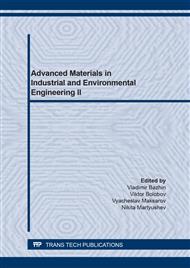[1]
M. Bengisu, Engineering Ceramics, Springer Science & Business Media, (2013).
Google Scholar
[2]
I. Gibson, D. Rosen, B. Stucker, Additive manufacturing technologies: 3D printing, rapid prototyping, and direct digital manufacturing, Springer-Verlag, New York, (2015).
DOI: 10.1007/978-1-4939-2113-3
Google Scholar
[3]
I. Gibson, D. Rosen, B. Stucker, Additive manufacturing technologies: 3D printing, rapid prototyping, and direct digital manufacturing, Springer-Verlag, New York, 2015, p.498.
DOI: 10.1007/978-1-4939-2113-3
Google Scholar
[4]
H.L. Marcus, J.J. Beaman, J.W. Barlow, D.L. Bourell, Solid freeform fabrication powder processing, American Ceramic Society Bulletin 69(6) (1990) 1030–1031.
Google Scholar
[5]
E. Sachs, M. Cima, J. Cornie, Three-dimensional printing: rapid tooling and prototypes directly from a CAD model, CIRP Annals-Manufacturing Technology 39(1) (1990) 201–204.
DOI: 10.1016/s0007-8506(07)61035-x
Google Scholar
[6]
A.P. Zhang, X. Qu, P. Soman, K.C. Hribar, J.W. Lee, S. Chen, S. He, Rapid fabrication of complex 3D extracellular microenvironments by dynamic optical projection stereolithography, Adv. Mater. 24(31) (2012) 4266–4270.
DOI: 10.1002/adma.201202024
Google Scholar
[7]
M.P. Lee, G.J. Cooper, T. Hinkley, G.M. Gibson, M.J. Padgett, L. Cronin, Development of a 3D printer using scanning projection stereolithography, Scientific reports 5 (2015) 9875.
DOI: 10.1038/srep09875
Google Scholar
[8]
J. Liu, B. Zhang, C. Yan, Y. Shi, The effect of processing parameters on characteristics of selective laser sintering dental glass-ceramic powder, Rapid Prototyping Journal 16(2) (2010) 138–145.
DOI: 10.1108/13552541011025861
Google Scholar
[9]
A. Clare, P. Chalker, S. Davies, C. Sutcliffe, S. Tsopanos, Selective laser sintering of barium titanate–polymer composite films, Journal of Materials Science 43(9) (2008) 3197–3202.
DOI: 10.1007/s10853-007-2396-x
Google Scholar
[10]
C. Gao, B. Yang, H. Hu, J. Liu, C. Shuai, S. Peng, Enhanced sintering ability of biphasic calcium phosphate by polymers used for bone scaffold fabrication, Materials Science and Engineering: C 33(7) (2013) 3802–3810.
DOI: 10.1016/j.msec.2013.05.017
Google Scholar
[11]
B. Cappi, E. Ozkol, J. Ebert, R. Telle, Direct inkjet printing of Si3N4:Characterization of ink, green bodies and microstructure, Journal of the European Ceramic Society 28(13) (2008) 2625–2628.
DOI: 10.1016/j.jeurceramsoc.2008.03.004
Google Scholar
[12]
J.A. Lewis, J.E. Smay, J. Stuecker, J. Cesarano, Direct ink writing of three-dimensional ceramic structures, Journal of the American Ceramic Society 89(12) (2006) 3599–3609.
DOI: 10.1111/j.1551-2916.2006.01382.x
Google Scholar
[13]
E. Feilden, E.G.-T. Blanca, F. Giuliani, E. Saiz, L. Vandeperre, Robocasting of structural ceramic parts with hydrogel inks, Journal of the European Ceramic Society 36(10) (2016) 2525–2533.
DOI: 10.1016/j.jeurceramsoc.2016.03.001
Google Scholar
[14]
H. Elsayed, P. Colombo, E. Bernardo, Direct ink writing of wollastonite-diopside glass-ceramic scaffolds from a silicone resin and engineered fillers, Journal of the European Ceramic Society 37(13) (2017) 4187–4195.
DOI: 10.1016/j.jeurceramsoc.2017.05.021
Google Scholar
[15]
N.M. Pavlushkin, Sintered corundum, Construction, Energy and Building Materials Publishing House, Moscow, (1961).
Google Scholar
[16]
S.P. Bogdanov, N.A. Khristiuk, V.V. Kozlov, A.S. Dolgin, Ceramics Sintering from Corundum Powders Clad with Iodine Transmission, Glass Physics and Chemistry 45(6) (2019) 573–579.
DOI: 10.1134/s1087659620010034
Google Scholar
[17]
S.P. Bogdanov, Preparation of coatings on powders by iodine transport, Glass Physics and Chemistry 37(2) (2011) 229–237.
Google Scholar
[18]
S.P. Bogdanov, A.P. Garshin, M.M. Sychev, Armored ceramics based on corundum powders core-shell,, Collection of reports of the 11th International Symposium Powder Metallurgy: Surface Engineering, New Powder Composite Materials 1 (2019) 424-430.
Google Scholar


